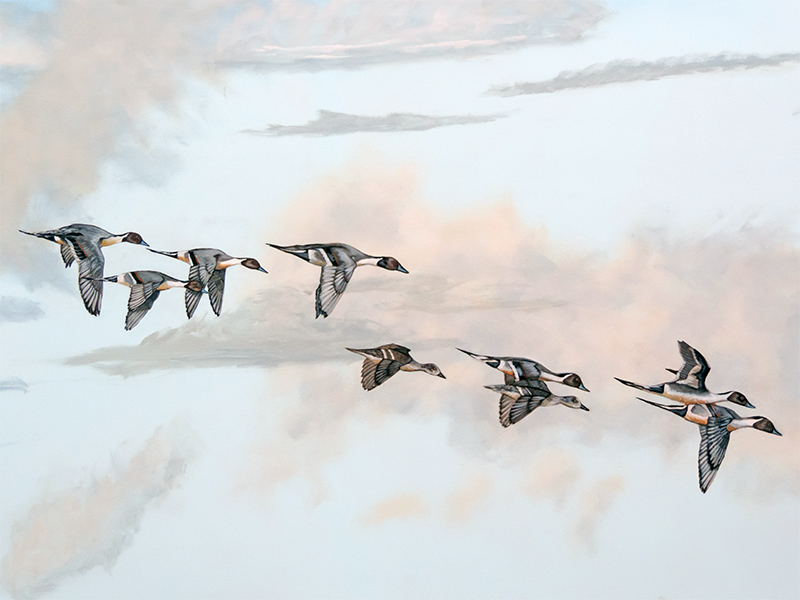Masters of the Sky
Discover the raptors and birds that utilize the Upper Mississippi River Flyway’s highway in the sky.
The skies above the Upper Mississippi River are a natural highway used by songbirds, waterfowl, and raptors. Known as the Upper Mississippi River Flyway, it sees millions of birds pass through each spring and fall. It provides critical habitat and food sources for birds during the long and dangerous journey known as migration. The Masters of the Sky exhibit explores what makes a raptor a “raptor”, and also introduces guests to the wide variety of birds they can expect to see in the skies above Minnesota and Wisconsin.
Exploring the Mural
Masters of the Sky features a beautifully detailed mural on the walls encircling the second floor exhibit space. Painted by Wabasha artist Sue Mundy in 2013, it features depictions of several different species of birds and raptors during migration. This page serves as your guide to the scenes depicted above your head. As you scroll through this page, you will see selected scenes along with explanations of what you are seeing.
The Kettle
“Kettle” is a term that refers to a large group of raptors soaring together in the sky. It derives from the similarity in appearance to a boiling kettle of water, with bubbles swirling and rising upward. As raptors ride rising currents of warm air known as thermals, they create these swirling formations.
This depiction is based on an actual kettle observed at Hawk Ridge Observatory in Duluth, MN by Director of Education Scott Mehus. The mural contains 429, but the actual kettle consisted of over 500 hundred raptors, most of which were Broad-winged Hawks. Other species shown in this mural kettle include Mississippi Kites and Swainson’s Hawks.
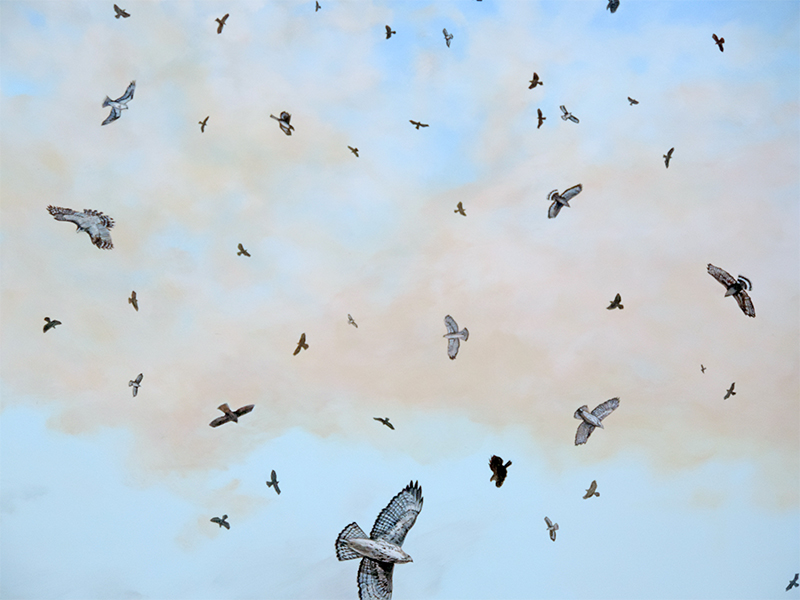
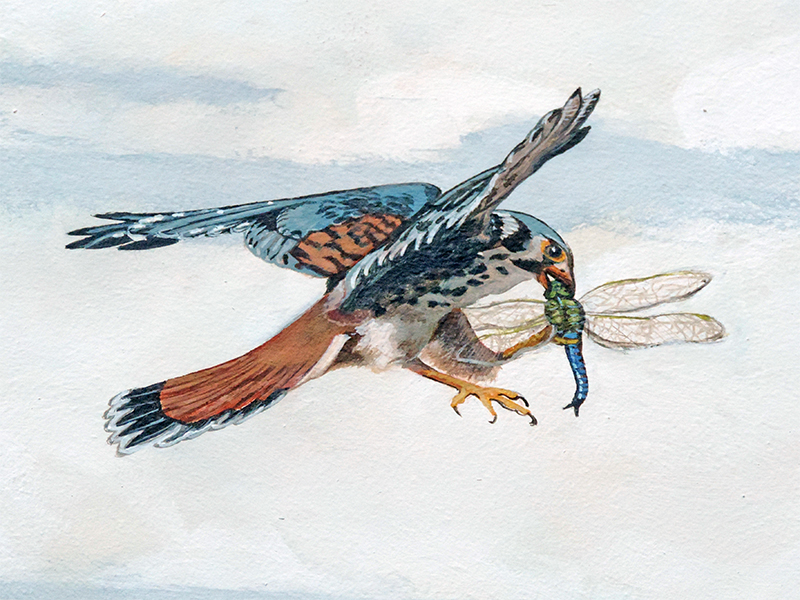
American Kestrel
The Upper Midwest and Mississippi River Valley are home to North America’s smallest raptor – the American Kestrel. These small, but fierce raptors feature flashy plumage and are commonly seen perching on power lines and the top of telephone poles along roads and highways. They hunt small rodents and insects. The Kestrel that appears in this mural has a Green Darner dragonfly in its clutches.
Female Kestrels typically move south during the winter months, while males remain all year-round. Be sure to keep a sharp eye out as you drive through the Upper Midwest and you may spot a Kestrel on the hunt.
Flocks and Hunters
The mural shows several groups of birds, including this flock of American Robins. Migration is a serious undertaking for birds, covering long distances and requiring a lot of energy to fuel the journey. On top of that, songbirds face the added danger of being preyed upon by predators. In this portion of the mural, we see a bird-eating raptor – a juvenile Cooper’s Hawk (upper left) – chasing the flock of Robins.
For added protection, many songbirds migrate at night when they are harder to spot by predators. Night migration also means cooler temperatures during flight, which helps conserve energy.
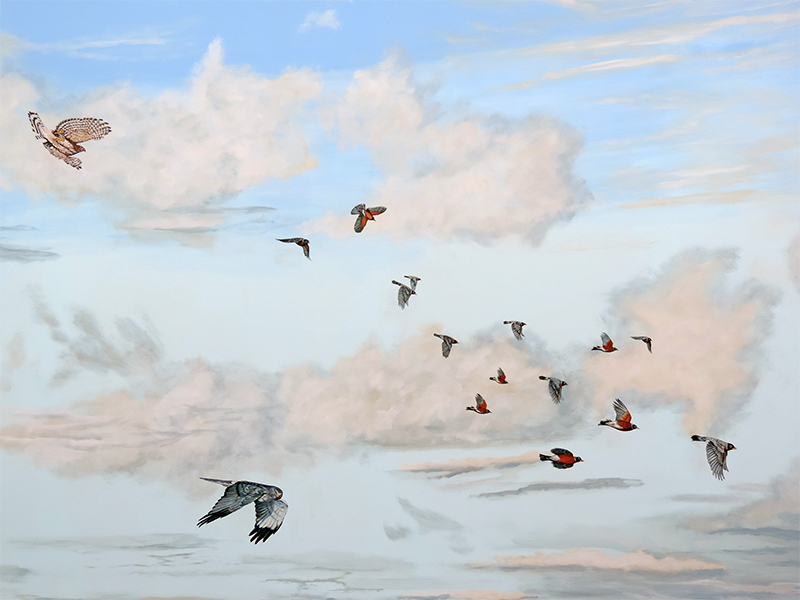
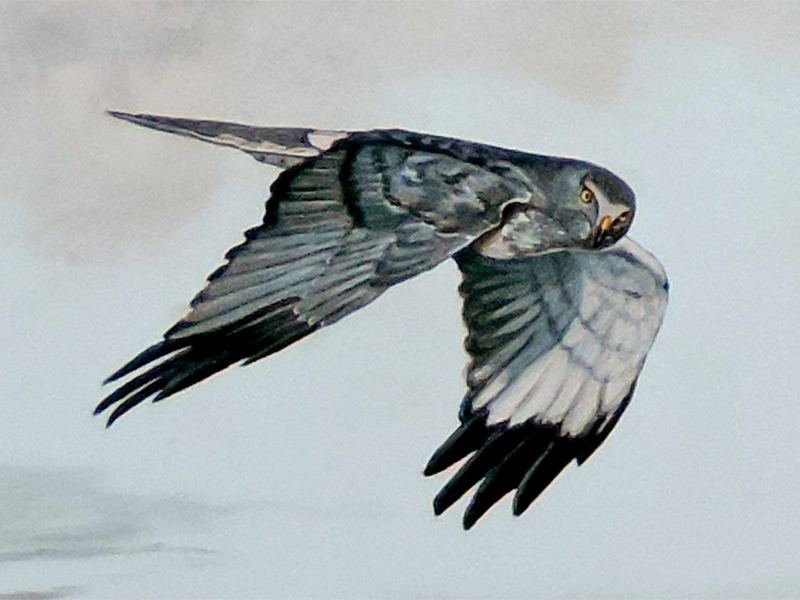
Northern Harrier
Many species call the marshy landscape that flanks the Mississippi River home, including the Northern Harrier. This hunter of small mammals, reptiles, and songbirds has a unique appearance, and its white face, breast, and gray back have earned it the nickname “the gray ghost”. Unlike most raptors (except for owls), the Harrier hunts using both sight and sound. This is possible due to the facial disc feathers that direct sound toward its ears, just like an owl. You will typically see Harrier hunting by gliding low over the ground.
The Harrier depicted in the mural (below the Robins) is a male. Females feature a brown plumage and light ring around their necks that resembles a necklace.
Rough-Legged Hawk
Come fall, many birds leave Minnesota and Wisconsin and migrate south to warmer climates to overwinter. Some species come south to the Upper Midwest from northern Minnesota and Canada for the winter. Rough-Legged Hawks are among them, and these spectacular raptors are often observed hovering over fields as they hunt for mice, voles, and shrews.
Similar in size to Red-Tailed Hawks, this boldly patterned species comes in two distinct “morphs” or plumage variations. The morph depicted in the Masters of the Sky mural is a “light morph”, with a lighter breast and undersides of the wings and distinct dark patches at the wrist. “Dark morph” individuals feature a dark breast and dark undersides of the wings. All feature tails that are dark at the tip and pale at the base.
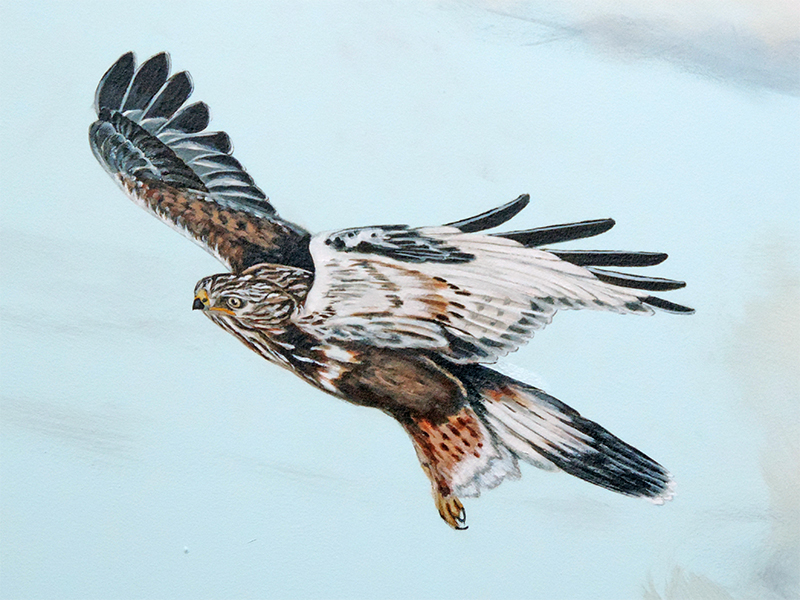
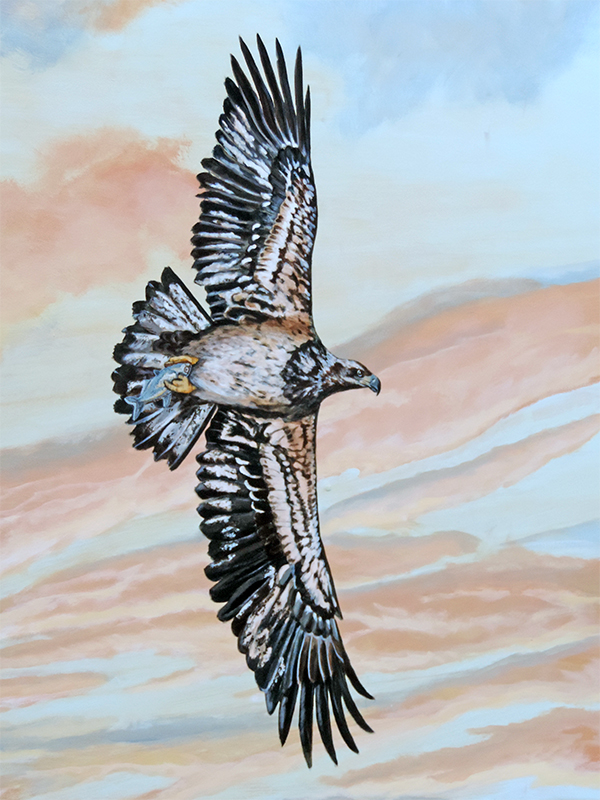
Juvenile Bald Eagle
Bald Eagles are true Masters of the Sky and a common sight along the Mississippi River. In fact, in total population size, Minnesota ranks second among the states, and Wisconsin ranks fourth. Even during the peak of endangerment in the 1970s and 80s, the Wabasha area remained a bastion for winter Bald Eagle viewing.
Juvenile Bald Eagles do not look anything like adults, lacking that iconic white head and tail. Instead, they are mostly brown and slowly transition to their adult plumage over a period of four to six years. This frequently leads to an understandable misidentification of Golden Eagles by casual observers. However, ongoing research, such as the Golden Eagle Project, tells us that Golden Eagles are only found in the Upper Midwest during the winter months, and are rarely observed near the water.
The individual depicted in the mural represents the wide diversity of plumage observed among juvenile Bald Eagles. This eagle is very light for a juvenile, even by Bald Eagle standards. However, the white “axillaries” (wingpits), dark beak, and the fish in its talons give away its identity as a Bald Eagle. Did you notice the fish in the eagle’s talons?
Non-Raptor Species Depicted
Tundra Swans
One of the region’s special seasonal attractions is Tundra Swan migration in late fall. Tundra Swans have a long migration from their nesting territory in western Canada to their winter territory in the Chesapeake Bay on the Atlantic coast. Along the way, they stop over on the Upper Mississippi River for around a month as they feed on Arrowroot tubers, potato-like root vegetables rich in carbohydrates and other nutrients, that grow in the shallow backwaters. These refuel the swans for the second leg of their journey.
Tundra swans migrate as family units and are observed in the hundreds to tens of thousands at viewing locations along the Upper Mississippi each fall.
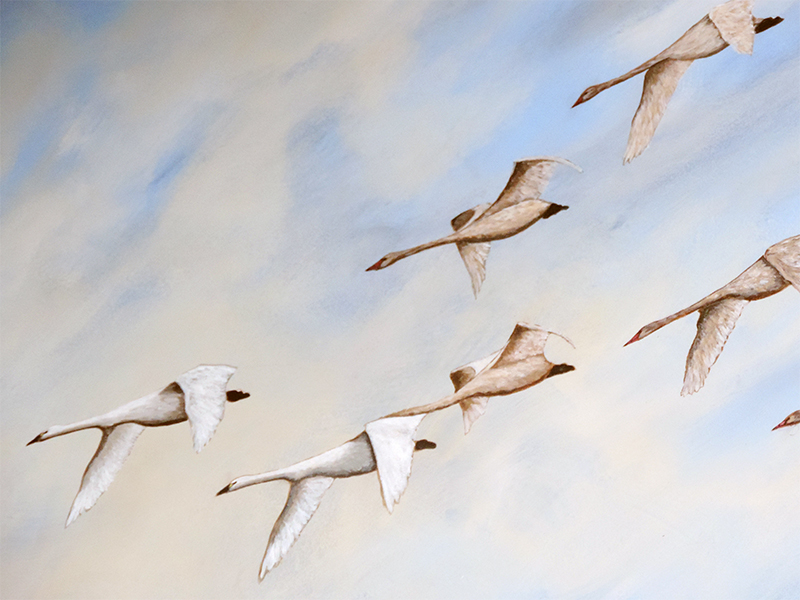
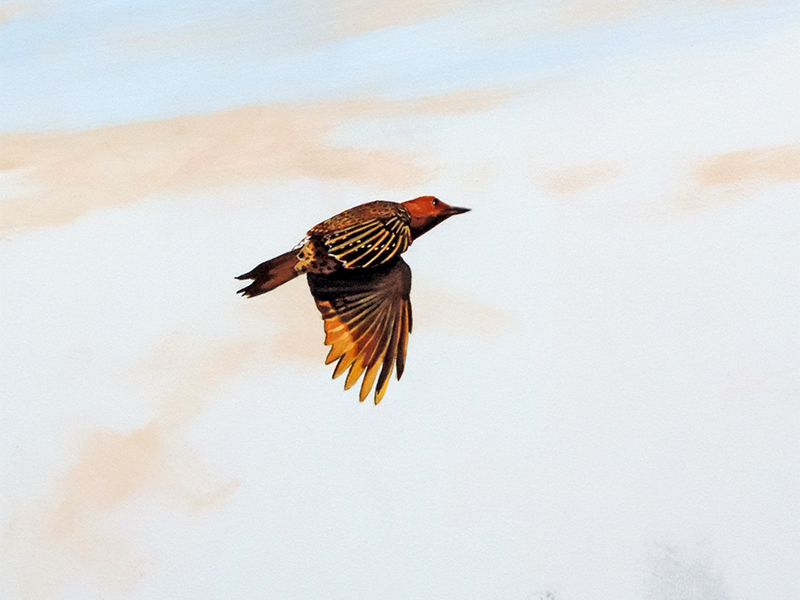
Northern Flicker
Of all the birds observed in the Upper Mississippi River Valley, few are as striking and uniquely patterned as the Northern Flicker. This member of the woodpecker family features a tannish/brown base with flashes of red, yellow, grey, and black displayed as spots on the belly, bars, and crescents on the face and nape of the neck. Eastern birds have a yellow underside to their wings and tails, while western birds feature red. It’s a showy bird!
The Northern Flicker is a resident of wooded areas and, unlike most other woodpeckers, typically spends much of its time foraging on the ground. You’re most likely to hear their rolling rattle song in the spring when they establish nesting territory, but may also hear their “kyeer” call throughout the year.
Waterfowl
Every spring and fall, migration sees approximately 325 bird species move through the Mississippi River Flyway. Many of these species are ducks and waterfowl, and these are represented in the mural by a flock of Northern Pintail. These elegant ducks are easily identified in flight by their iconic long and thin tail feathers. They are just one of many species observed along the river with different species observed during the summer and winter.
